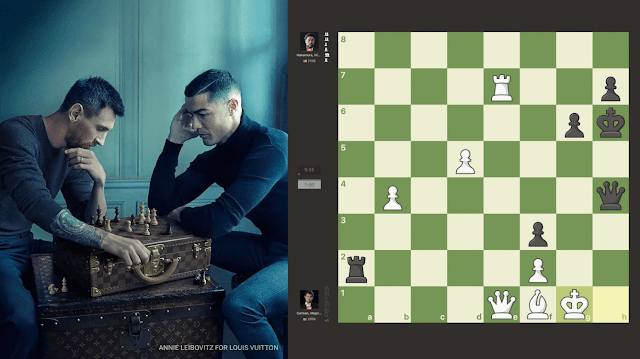This first commentary game from the 2022 U.S. championships features FM Ashritha Eswaran vs. FM Alice Lee. I found it interesting because of the themes surrounding White's chosen opening setup, technically an English Opening but one that could be reached from different move orders. Instead of classical development, White goes for an early g-pawn thrust, which works well but results in complications that lead Eswaran astray. Move 14 is critical in that respect, with sacrificial tactics for White that could have lead to an advantage.
Also interesting is to compare it with their 2021 game in the U.S. championship, in which Eswaran chose to fianchetto and play a King's Indian Attack setup.
| Replay and check the LiveBook here |
Please, wait...
1.c4 c6 2.Nf3 d5 3.e3 Nf6 4.Nc3 e6 5.b3 Nbd7 6.Bb2 Bd6 7.Qc2 0-0 8.Rg1 Re8 9.g4 Nf8? 9...e5 10.g5± N6d7 11.h4 a6 12.h5 12.d4 12...b5 13.Bd3 Bb7 14.g6?! 14.Bxh7+ Nxh7 15.Nxb5 Ndf8 15...axb5 16.g6 16.g6 fxg6 17.Nxd6 Qxd6 14...fxg6 15.Ng5 bxc4 15...h6!? 16.bxc4 h6 17.Nf7 Kxf7 18.Bxg6+ Ke7 18...Kg8? 19.Bxe8 Ne5 19...Qxe8? 20.Ne4+- 20.0-0-0 Qxe8 21.f4!± 19.Bxe8 Qxe8 20.Rxg7+ Kd8 21.Qa4? Qxh5 22.cxd5 exd5 23.Qa5+ Ke8 24.Ba3 c5! 25.Rb1 d4-+ 26.exd4 26.Rxb7 Qh1+ 27.Ke2 Qxb7 26...Qh1+ 27.Ke2 Bf3+ 28.Kd3 Be4+ 29.Nxe4 Qxb1+ 30.Ke3 cxd4+ 31.Kxd4 Ne6+ 32.Ke3 Bf4+ 33.Kf3 Ne5+ 34.Ke2 Qxe4+ 35.Kd1 Nxg7 36.Qc5 Qf3+ 37.Kc2 Qc6 0–1
- Start an analysis engine:
- Try maximizing the board:
- Use the four cursor keys to replay the game. Make moves to analyse yourself.
- Press Ctrl-B to rotate the board.
- Drag the split bars between window panes.
- Download&Clip PGN/GIF/FEN/QR Codes. Share the game.
- Games viewed here will automatically be stored in your cloud clipboard (if you are logged in). Use the cloud clipboard also in ChessBase.
- Create an account to access the games cloud.
| Eswaran,A | 2365 | Lee,A | 2263 | 0–1 | A11 | 1 |
Please, wait...
 |
| Evaluation chart generated by HIARCS Chess Explorer Pro |


